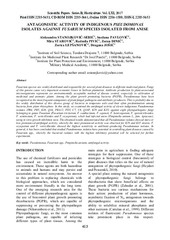Приказ основних података о документу
Antagonistic activity of indigenous Pseudomonas isolates against fusarium species isolated from anise
| dc.creator | Stanojković-Sebić, Aleksandra | |
| dc.creator | Pavlović, Snežana | |
| dc.creator | Starović, Mira | |
| dc.creator | Pivić, Radmila | |
| dc.creator | Dinić, Zoran | |
| dc.creator | Ljepšanović, Zorica | |
| dc.creator | Jošić, Dragana | |
| dc.date.accessioned | 2023-09-24T22:18:55Z | |
| dc.date.available | 2023-09-24T22:18:55Z | |
| dc.date.issued | 2017 | |
| dc.identifier.issn | 2285-5653 | |
| dc.identifier.uri | https://plantarum.izbis.bg.ac.rs/handle/123456789/1022 | |
| dc.description.abstract | Fusarium species are widely distributed and responsible for several plant diseases in different medicinal plants. Fungi of this genera cause very important economic losses in Serbian plantation. Antibiotic production by plant-associated microorganisms represents an environmentally acceptable method of disease control, esspecialy in cultivation of medicinal and aromatic plants. Among the plant growth promoting bacteria (PGPB), Pseudomonas have been recognized as the most frequent antagonists of plant fungal pathogens and antibiotic producers. This is probably due to the widely distribution of this diverse group of bacteria in temperate soils and their often predomination among bacteria from plant rhizosphere. In this study, we examined the antifungal activity of eleven indigenous Pseudomonas isolates (PB4, PB5, K38, Q34, PBA12, PD5, C7, C8, Q16P, K29 and K35) against eight phytopathogenic fungi belonging to genus Fusarium (Fusarium tricinctum, F. sambucinum, F. equiseti, F. heterosporum, F. sporotrichioides, F. semitectum, F. verticillioides and F. oxysporum), which had infected anise (Pimpinella anisum L., fam. Apiaceae), using in vitro growth inhibition tests. The obtained results demonstrated that all Pseudomanas isolates showed more or less pronounced antifungal activity, whereby the most pronounced activity was observed for K29 and K35 strains. F. oxysporum and F. verticillioides showed the highest sensitivity to antibiotic-producing Pseudomanas isolates. In general, it has been concluded that studied Pseudomonas isolates have potential in controlling plant diseases caused by Fusarium spp., whereby the bacterial isolates with the highest inhibitory potential will be selected for further experiments. | sr |
| dc.language.iso | en | sr |
| dc.publisher | University of agronomic Sciences and veterinary medicine of Bucharest Faculty of Horticulture | sr |
| dc.relation | info:eu-repo/grantAgreement/MESTD/Integrated and Interdisciplinary Research (IIR or III)/46007/RS// | sr |
| dc.rights | openAccess | sr |
| dc.rights.uri | https://creativecommons.org/licenses/by/4.0/ | |
| dc.source | Scientific Papers: Series B. Horticulture | sr |
| dc.subject | Pseudomonas | sr |
| dc.subject | Fusarium spp | sr |
| dc.subject | Pimpinella anisum | sr |
| dc.subject | antifungal activity | sr |
| dc.title | Antagonistic activity of indigenous Pseudomonas isolates against fusarium species isolated from anise | sr |
| dc.type | article | sr |
| dc.rights.license | BY | sr |
| dc.citation.epage | 416 | |
| dc.citation.spage | 413 | |
| dc.citation.volume | 41 | |
| dc.type.version | publishedVersion | sr |
| dc.identifier.fulltext | http://plantarum.izbis.bg.ac.rs/bitstream/id/3347/bitstream_3347.pdf | |
| dc.identifier.wos | 000414551900061 |


